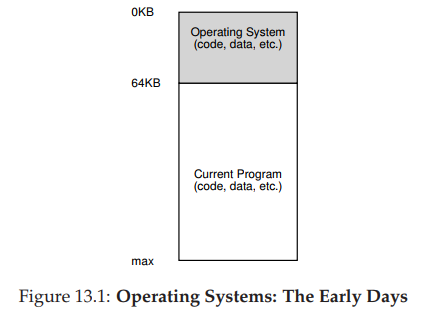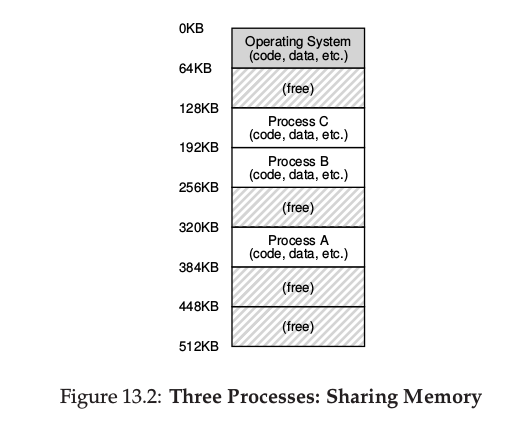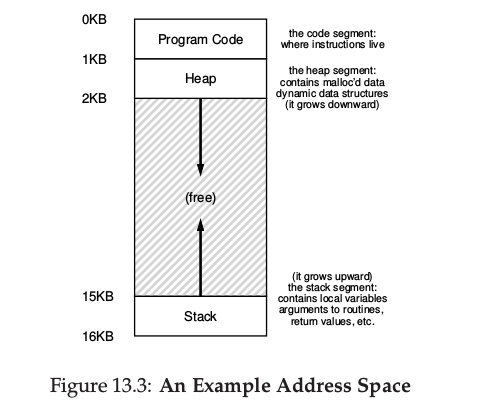介绍
早期的操作系统实现功能起来很简单,一般看来,物理内存的结构就一般分为俩快:一块用来存os的代码和数据,另一块给当前程序的代码和数据。就像下图:

但是随着多程序的诞生,为了避免在进程间频繁的切换损失性能,所以重新设计了内存的结构,来增加效率,就像下图这样,每个进程都有自己的私有空间,保护了进程的安全,不受其他进程影响

为了用起来方便,我们让操作系统创建了物理内存的抽象,叫做地址空间 address space,它是运行中程序的视图,地址空间是内存虚拟化的关键,进程的地址空间包含所有在运行中程序的记忆状态;用地址空间的顶部来存静态代码,提高空间利用率;用栈区来保存函数调用链,局部变量,传递形参,返回值等;用堆区来动态分配内存,用户管理内存,例如c语言里的malloc()和c++里面的new,其他的还有静态区 我们抽象的假设code区在顶部,它的下面是heap区,堆动态向下增长,堆的下面是free区,free区的下面是stack区,stack会动态向上增长。

然而事实上进程在内存中的地址是随机

所以就出现了虚拟化内存virtualizing memory,即操作系统为正在运行的多个进程分配私有、潜在、独立的地址空间,所有的虚拟地址都会被操作系统翻译成真实物理地址,然后就可以获取到各种值和信息
可以写段代码测试下内存中的虚拟地址
#include <stdio.h>
#include <stdlib.h>
/*打印code, heap, stack三个区的虚拟地址,十六进制表示*/
int main(int argc, char *argv[])
{
printf("location of code : %p\n", (void *) main); // main函数开始地址
printf("location of heap : %p\n", (void *) malloc(1));
int x = 3;
printf("location of stack : %p\n", (void *) &x);
return x;
}
/*
大致结果:
location of code : 0x4005d6
location of heap : 0xcc1420
location of stack : 0x7ffde8e29124
*/
分配和管理内存
操作系统提供了一些api来给用户管理内存 1.types of memory 一般的程序,都有编译器暗中为你在stack区中allocate和deallocate内存, 而heap区中的分配和释放内存则由程序员手动来操作 2.malloc() call 属于libary call,不是system call
#include <stdlib.h>
...
void *malloc(size_t size);
3.free() call 释放内存例子
int *x = malloc(10 * sizeof(int));
...
free(x);
4.管理内存时易犯错误 1)忘记分配内存
// Allocate Memory
char \*src = "hello"; char \*dst; // oops! unallocated
strcpy(dst, src); // segfault and die
2)未分配足够内存
(char *) malloc(strlen(src)); // too small (char *)
malloc(strlen(src) + 1); // properly
3)Forgetting to Initialize Allocated Memory 忘记填分配的数据类型,则可能会导致uninitialized read
4).忘记free内存 忘记释放内存会导致内存泄露leaking memory 有点语言会自动garbage-collected,但是有的资源gc是不会释放的
5).free 调用错误 free()错误,参数需要指针类型 测试例子:
#include <stdio.h>
#include <stdlib.h>
#include <string.h>
int main(int argc, char *argv[])
{
/*
int *x = (int *) malloc(sizeof(int));
printf("%p\n", x);
*/
/* 错误,执行时错误
char *src = "hello";
char *dst; // oops! unallocated
strcpy(dst, src); // segfault and die
*/
/* 正确 */
char *src = "hello";
char *dst = (char *) malloc(strlen(src) + 1);
strcpy(dst, src); // work properly
return 0;
}
/*
编译过程:
看到 int *x 的时候,为整型指针创建一个临时空间
看到 malloc 的时候,把整型指针heap中的一个地址
最后函数返回地址存在stack上
*/
地址翻译 address translation
问题:给一个测试代码,问os如何从内存中加载一个值
void func() {
int x = 3000; // thanks, Perry.
x = x + 3; // this is the line of code we are interested in
首先c编译器会将代码按行转化成汇编,像下面这样
128: movl 0x0(%ebx), %eax ;load 0+ebx into eax
132: addl $0x03, %eax ;add 3 to eax register
135: movl %eax, 0x0(%ebx) ;store eax back to mem
这段汇编代码大意就是:首先x的地址被替换为寄存器ebx,下一步用 move 指令从寄存器ebx中加载出x的值,然后给ebx加上3,最后返回寄存器ebx的在内存中的某个地址 通过地址翻译,操作系统能控制进程的每次访问